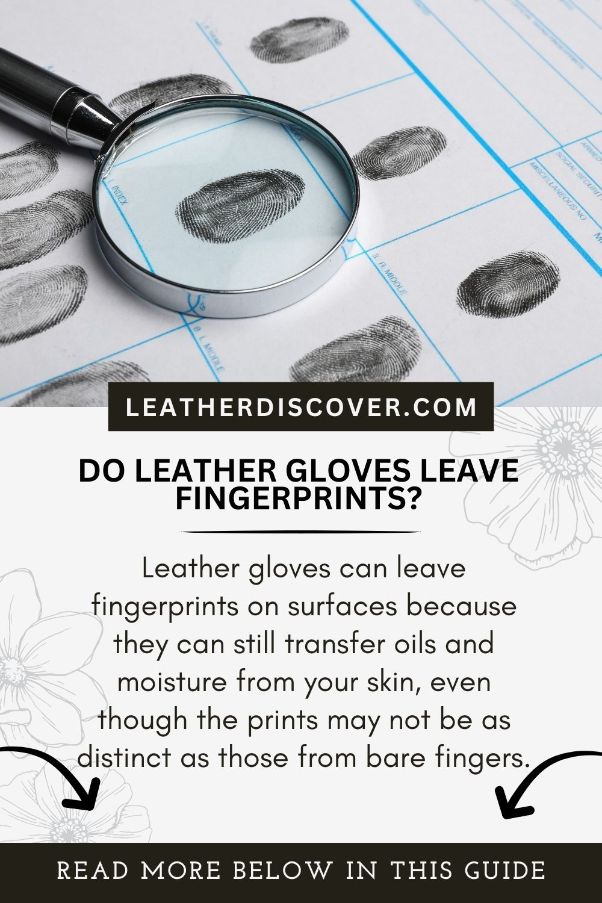Leather gloves, with their soft and supple texture, are known for their comfort and versatility. They are a popular choice for a variety of activities, from driving to fashion statements.
However, a common question that arises is whether leather gloves, like those made of other materials, leave fingerprints. The answer to this question delves into the unique characteristics of leather as well as the factors that may affect its interaction with surfaces.
In this guide, we will explore: Do leather gloves leave fingerprints, what gloves do not leave fingerprints, how long fingerprints stay on leather gloves, and more!
[toc]

Do Leather Gloves Leave Fingerprints?
Leather gloves typically do not leave discernible fingerprints as bare fingers do. The reason behind this lies in the nature of leather itself. Leather is a porous material that absorbs oils and moisture from your skin, reducing the likelihood of leaving clear fingerprints on surfaces.
However, it’s important to note that while leather may not leave traditional fingerprints, it can still transfer oils and some residue to surfaces, especially if the gloves are dirty or oily. This transfer may not be as distinct as fingerprints, but it can leave subtle marks over time, particularly on surfaces like glass or polished metal.
To minimize any potential transfer of residue or marks from your leather gloves, it’s a good practice to keep them clean and free from excess oils or dirt.
Additionally, handling sensitive or clean surfaces with caution while wearing leather gloves is advisable to prevent any unintended marks or smudges.
Possibility of Getting Fingerprints on Gloves:
While gloves are designed to provide a barrier between your hands and surfaces, it’s important to understand that fingerprints can still transfer to gloves under certain circumstances.
Here are a few factors to consider regarding the possibility of getting fingerprints on gloves:
1. Glove Material and Texture:
The material and texture of the gloves can impact the likelihood of fingerprints transferring.
Gloves with smoother surfaces, such as latex or nitrile gloves, are less likely to pick up and retain visible fingerprints compared to gloves with textured surfaces, like some fabric or leather gloves.
2. Natural Oils and Sweat:
Your skin naturally produces oils and sweat that can transfer to gloves.
Even if the gloves have a smooth surface, some oil and moisture can still transfer from your skin to the gloves, potentially leaving behind traces of your fingerprints.
3. Glove Fit:
Gloves that fit snugly against your skin are more likely to pick up any oils and sweat from your hands. The close contact can facilitate the transfer of substances, including fingerprints, from your skin to the gloves.
4. Handling Objects:
If you handle objects or surfaces that have fingerprint residue and then touch your gloves, there’s a chance that the fingerprints from those surfaces could transfer to the gloves.
5. Handling Bare-Skin Areas:
When you touch bare-skin areas of your body, such as your face or neck, and then touch your gloves, you can transfer oils and other substances from those areas to the gloves.
6. Type of Activity:
The activities you engage in while wearing gloves can also affect the likelihood of fingerprints transferring. For example, if you handle objects that leave behind oils, dirt, or residue, those substances could transfer to the gloves.
7. Glove Cleanliness:
Regularly cleaning your gloves can help remove any transferred oils and substances, reducing the risk of visible fingerprints.
How Long Do Fingerprints Stay on Leather Gloves?
The longevity of fingerprints on leather gloves can vary based on factors such as the type of leather, the finish of the gloves, the amount of natural oils and sweat on your hands, and how often the gloves are worn.
Generally, fingerprints can be temporarily visible on leather gloves, especially if the leather is very soft or porous.
However, over time, these marks may fade as the natural oils on the leather redistribute and the leather regains its natural texture.
Leather is a natural material that can absorb and release oils and moisture, which can help minimize the visibility of fingerprints. The texture of leather, as well as any treatments it has undergone (such as conditioning or waterproofing), can influence how long fingerprints stay visible.
What Gloves Don’t Leave Fingerprints?
Gloves made from certain materials are less likely to leave visible fingerprints on surfaces. Here are some types of gloves that are known for leaving fewer fingerprints:
1. Cotton Gloves:
Cotton gloves have a softer and more porous texture compared to materials like latex or leather. They are commonly used for tasks that require a gentle touch and where fingerprint transfer is a concern, such as handling delicate objects or artifacts.
2. Nitrile Gloves:
Nitrile gloves are often used in medical and laboratory settings. They have a smooth surface that reduces the likelihood of leaving visible fingerprints. However, they can still transfer small amounts of oils and marks, especially if the gloves are well-worn.
3. Vinyl Gloves:
Vinyl gloves, similar to nitrile gloves, have a smooth texture that reduces the chances of leaving visible fingerprints. They are commonly used in medical, food service, and cleaning industries.
4. Silk Gloves:
Silk gloves are very delicate and smooth, making them less likely to leave visible fingerprints. They are often used for formal occasions and events.
5. Thin Liner Gloves:
Thin-liner gloves made from materials like silk, nylon, or lightweight synthetic blends are designed to provide an extra layer of protection without interfering with tactile sensation. These gloves can be worn underneath other gloves to minimize fingerprint transfer.
How to Not Leave Fingerprints Without Gloves?
If you want to avoid leaving fingerprints on surfaces without wearing gloves, here are some tips to consider:
1. Wash Your Hands:
Washing your hands before touching surfaces can help reduce the transfer of oils and sweat that can leave behind fingerprints.
2. Use a Cloth or Tissue:
If you need to touch a surface, you can use a clean cloth, tissue, or paper towel to create a barrier between your fingers and the surface. This can help prevent direct contact and the transfer of oils.
3. Be Mindful of Contact:
Be conscious of the surfaces you touch and avoid unnecessary contact with sensitive or valuable objects whenever possible.
4. Avoid Touching Bare-Skin Areas:
Try to avoid touching your face, neck, or other areas of your body that might have natural oils before touching surfaces.
5. Regularly Clean Surfaces:
Regularly cleaning surfaces with a gentle cleaner can help remove oils and residue, reducing the visibility of fingerprints.
6. Use Fingerprint-Resistant Products:
Some products are designed to be fingerprint-resistant, including certain coatings or finishes for surfaces. Consider using these products if you’re concerned about marks.
7. Gentle Handling:
Be gentle when touching surfaces to avoid leaving behind unnecessary marks. Use the least amount of pressure necessary.
Conclusion:
So, now you know the answer to the question “Do leather gloves leave fingerprints?” is no.
When seeking ways to evade fingerprints without gloves, a combination of conscious habits and gentle practices emerges as a strategy.
Embracing clean hands, the thoughtful use of barriers like cloths, and employing specialized products where applicable all contribute to minimizing the impact of our tactile interactions.
- What Is Caiman Leather? A Detailed Guide - July 25, 2024
- What Is Tumbled Leather?A Complete Guide - July 25, 2024
- What Is Kip Leather? Premium Leather Choice - July 24, 2024

